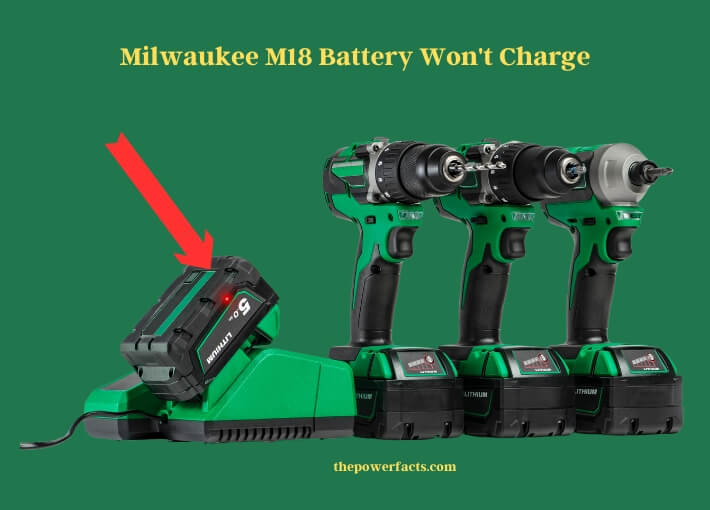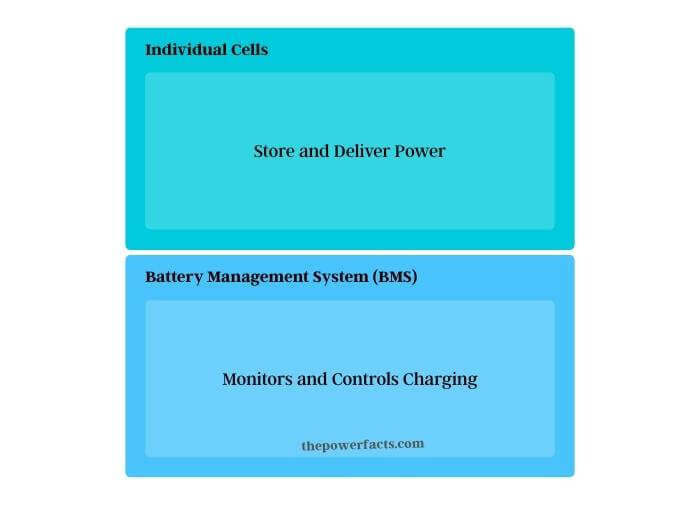Published on: November 13, 2023
Written by Jonas Frank / Fact-checked by Nova Scarlett
A common issue with Milwaukee M18 batteries is their failure to charge, often indicated by a green light. This problem can be frustrating, especially for those relying on their tools for work or projects.
Milwaukee M18 batteries may show a green light yet fail to charge due to several reasons. A simple reset can sometimes solve the issue. To perform a reset, remove the battery from the charger, then reinsert it. If this doesn’t work, checking the diagnostic codes can provide insight. These codes are specific patterns of lights that indicate various problems, such as temperature issues or internal faults. Understanding these codes is crucial for troubleshooting.
In some cases, the Milwaukee battery may display a flashing red and green light. This is often a sign of a deeper problem, possibly related to the battery cells. A similar issue is noted with the Milwaukee M12 battery, where it might not charge at all. These problems often require more technical solutions, like checking the individual cells or even replacing the battery.
Another common problem is when the battery indicates it’s fully charged, but it doesn’t work. This can be due to a miscommunication between the battery and the tool or charger. Similarly, an M18 battery that only charges to three bars indicates a partial charge, suggesting potential cell imbalance or degradation.

For more detailed information on resolving these issues and ensuring your Milwaukee batteries function optimally, reading the full article is recommended. It provides step-by-step guidance and deeper insights into maintaining and troubleshooting your Milwaukee M18 battery.
Milwaukee M18 Battery Won’t Charge
The Charging Process of Milwaukee M18 Batteries
Basics of Milwaukee M18 Battery Charging
Milwaukee M18 batteries are the powerhouse behind many tools, but their charging process can sometimes be a puzzle. It’s like a dance between the charger and the battery, where both need to be in sync. When you plug in your battery, the charger evaluates its condition before initiating the charge. It’s not just about pumping power into the battery; it’s a delicate process that ensures the battery’s health and longevity. This process involves monitoring temperature, voltage, and current to provide an optimal charge. When it goes smoothly, your battery is ready to tackle any job. But when there’s a hiccup, it can throw a wrench in your plans.
Common Indicators of Charging Issues
Spotting charging issues early can save you a lot of trouble. Your Milwaukee M18 battery communicates its woes through lights and indicators. A solid green light should mean all is well, but sometimes it can be misleading. If your battery isn’t holding a charge despite the green light, it’s like getting a thumbs up from a friend who’s secretly upset. It’s a sign that something’s not quite right under the hood. Other indicators include flashing lights or no lights at all, which are like distress signals asking for your attention.
Diagnostic Codes and Their Meanings
Interpreting Milwaukee M18 Battery Diagnostic Codes
Your battery’s diagnostic codes are like its way of speaking to you. When you see a specific pattern of lights flashing, it’s trying to tell you something. These codes can indicate a range of issues, from temperature problems to internal malfunctions. Getting to know these codes is like learning a new language, one that can save you time and frustration. By understanding what your battery is trying to say, you can address issues more effectively, ensuring your tool is always ready for action.
Common Diagnostic Codes and Their Interpretations
| Diagnostic Code | Light Pattern | Possible Issue |
| Code 1 | Flashing Red | Overheated Battery |
| Code 2 | Flashing Green | Cold Battery |
| Code 3 | Alternating Red/Green | Faulty Battery |
| Code 4 | Solid Red | Charging Error |
| Code 5 | No Light | No Power to Charger |

Common Reasons Why Milwaukee M18 Batteries Won’t Charge
Environmental Factors Affecting Charging
You might not think about it, but the environment plays a big role in your battery’s charging process. Extreme temperatures, both hot and cold, can throw a wrench in the works. It’s like trying to charge your battery in a sauna or a freezer – it just won’t work right. Humidity and dust can also be troublemakers, interfering with the connection between the battery and the charger. Keeping your charging area clean and at a moderate temperature is like giving your battery a comfortable home where it can recharge in peace.
Internal Battery Issues and Lifecycle
Sometimes the problem lies within the battery itself. Over time, batteries can develop issues like memory effects or dead cells. It’s like having a team where one or two members aren’t pulling their weight – the whole team suffers. These internal problems can prevent your battery from charging fully or holding a charge. Regular maintenance and understanding your battery’s lifecycle can help you keep it in top shape and identify when it might be time for a replacement.
Troubleshooting Steps for Non-Charging Batteries
Initial Checks and Quick Fixes
When your battery won’t charge, start with the basics. Check the connections – are they clean and secure? It’s like making sure your phone’s charging cable is plugged in properly. Sometimes, simply removing and reinserting the battery can kickstart the charging process. This initial checkup is like giving your battery a quick health check – it can often solve simple problems and get you back to work.
Advanced Troubleshooting Techniques
If the basics don’t solve the problem, it’s time to roll up your sleeves. Check the individual cells in your battery. It’s like investigating each member of a team to find out who’s not pulling their weight. You might need a multimeter for this – it’s your detective’s magnifying glass. If you find a dead cell, it could be the root of your charging problems. This level of troubleshooting requires a bit more technical know-how, but it can be a rewarding challenge.
Milwaukee Battery Maintenance Best Practices
Routine Maintenance Tips for Longevity
Taking care of your Milwaukee M18 battery is key to its longevity. It’s like caring for a pet – regular attention keeps it healthy. Ensure the contacts are clean and free from debris, and avoid exposing the battery to extreme temperatures. Regularly cycling the battery – that is, using it until it’s nearly empty and then fully recharging it – can also help maintain its health. It’s like exercise for your battery, keeping it in top shape.
Storage and Handling Guidelines
How you store and handle your battery can greatly impact its lifespan. Store it in a cool, dry place, away from direct sunlight and moisture. It’s like finding the perfect parking spot for your car – sheltered and secure. Also, be gentle with it. Dropping or jarring the battery can cause internal damage, which might not be immediately apparent but can lead to problems down the line. Treat your battery with care, and it will serve you well for years.
Technical Insights: Inside Milwaukee M18 Batteries
Anatomy of a Milwaukee M18 Battery
Let’s take a peek inside your Milwaukee M18 battery. It’s like opening up a treasure chest to see what’s inside. The battery is made up of individual cells, all working together to store and deliver power. There’s also the battery management system (BMS), which is like the brain of the operation, keeping everything running smoothly. Understanding the inner workings of your battery can help you better maintain and troubleshoot it.
Components and Their Functions in Charging
| Component | Function in Charging |
| Individual Cells | Store and Deliver Power |
| Battery Management System (BMS) | Monitors and Controls Charging |

Professional Solutions and When to Seek Help
Signs You Need Professional Repair or Replacement
Sometimes, DIY fixes just won’t cut it. If your battery still won’t charge after you’ve tried troubleshooting, it might be time to call in the pros. Other signs include physical damage, like cracks or leaks, or if the battery overheats frequently. It’s like taking your car to a mechanic when the check engine light comes on – sometimes you need expert help.
Options for Professional Support
When it’s time to seek professional help, you have options. You can contact Milwaukee’s customer service for guidance or take your battery to a certified repair center. They have the tools and expertise to diagnose and fix deeper issues. It’s like having a team of doctors for your battery, ready to bring it back to health.
Milwaukee M18 Battery Enhancements and Alternatives
Upgrading Your Milwaukee M18 Battery
If you’re facing constant issues with your battery, maybe it’s time for an upgrade. Milwaukee offers a range of batteries with different capacities and features. It’s like upgrading from a basic phone to the latest smartphone – you get more power and better performance. An upgraded battery can breathe new life into your tools and make your work more efficient.
Alternative Battery Options and Compatibility
If an upgrade isn’t in the cards, consider alternative battery options. There are compatible batteries available that might better suit your needs. Just make sure they’re compatible with your tools. It’s like finding the right pair of shoes – they need to fit well to work well.
Summary
In this article, we’ve journeyed through the world of Milwaukee M18 batteries, from understanding their charging process to troubleshooting and maintenance. We’ve delved into the technical aspects and explored professional solutions. Keeping your Milwaukee M18 battery in top condition is key to getting the most out of your tools. Regular maintenance, understanding the signs of trouble, and knowing when to seek professional help can keep your battery charging smoothly and your tools running efficiently. Remember, your battery is the heart of your tool – take good care of it, and it will take good care of you.
